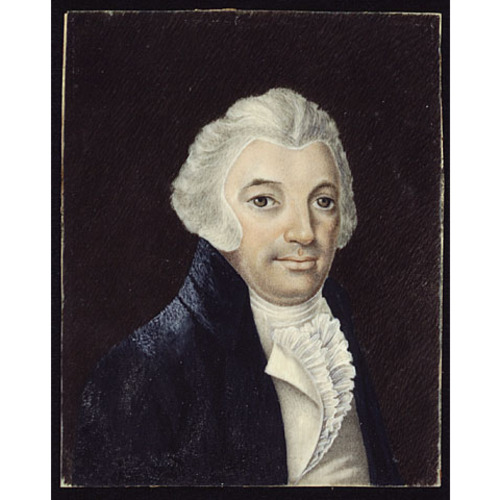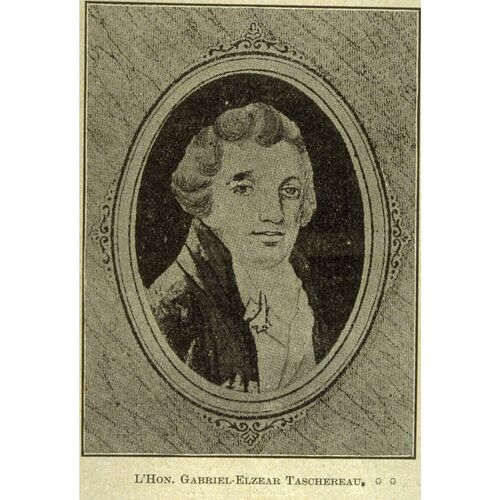TASCHEREAU, GABRIEL-ELZÉAR, seigneur, militia officer, office holder, judge, and politician; b. 27 March 1745 at Quebec, son of Thomas-Jacques Taschereau* and Marie-Claire de Fleury de La Gorgendière; m. there first 26 Jan. 1773 Marie-Louise-Élizabeth Bazin; m. secondly 3 Nov. 1789 Louise-Françoise Juchereau Duchesnay, daughter of Antoine Juchereau Duchesnay, in Beauport, Que.; d. 18 Sept. 1809 in Sainte-Marie-de-la-Nouvelle-Beauce (Sainte-Marie), Lower Canada.
At the age of four Gabriel-Elzéar Taschereau lost his father, and he grew up at Quebec with his mother. In 1759 he assisted in the defence of the town against the British; in the course of the siege the family house was burned. There is almost no trace of his activities until 1771, when as owner of a part both of Anticosti Island and of the seigneury of Mingan he granted trading leases to Thomas Dunn and William Grant (1744–1805). The following year Taschereau, himself heir to a portion of the seigneury of Sainte-Marie-de-la-Nouvelle-Beauce, bought his brothers’ and sisters’ rights of succession. Early in 1773 he completed his acquisitions by purchasing from his mother for 12,000 shillings half of both the seigneurial rights and the domain of Sainte-Marie-de-la-Nouvelle-Beauce, which comprised her share of the inheritance as widow of the recognized seigneur. Taschereau retained his dwelling at the corner of Rue Buade and Rue de la Montagne in Quebec but took up residence in Sainte-Marie-de-la-Nouvelle-Beauce. He established his mother and sister Marie there, each of them paying 2,000 shillings for a room in the seigneurial manor-house, heat, light, board, and care.
In 1775 the rebel American colonies were preparing to invade the province of Quebec [see Benedict Arnold]. Consequently, on 14 August Taschereau received a commission as adjutant holding the rank of captain. In September he reviewed the Canadian militia of Quebec, and then on 31 December he took part in the defeat of the Americans in the Lower Town [see Richard Montgomery*]. His loyalty to the British crown drew reprisals from some of his censitaires at Sainte-Marie-de-la-Nouvelle-Beauce who had dealings with the American troops. Moreover, early in 1776 the American rebels pillaged his domain and communal mill and sold the effects at auction. After the Americans had withdrawn, Taschereau, François Baby, and Jenkin Williams were appointed by Governor Guy Carleton to investigate the nature and extent of collaboration with the enemy in the Quebec region. In September and October Taschereau served on two commissions, one investigating all strangers who arrived in the province, the other the certificates of good conduct required of sellers of spirits. He was also appointed a justice of the peace that year.
In March 1777 Taschereau became a judge of the Court of Common Pleas for the District of Montreal. But he gave up this office soon after because all his interests were at Quebec and in the Beauce. In the course of that year he had bought part of the seigneury of Jolliet. In 1780 and 1781 he gained possession of almost the whole seigneury through the purchase of Joseph Fleury* Deschambault’s rights of succession and William Grant’s share. In 1778 he had handed over to Grant about £166, the sum he had had invested in a partnership with Nicolas-Joseph de Lafontaine de Belcour, François-Joseph Cugnet*, and François Baby to exploit the post of Saint-Augustin (Que.) on the Labrador coast.
In the next two decades, Taschereau continued his career at Quebec as a minor official. In 1787 Lord Dorchester, as Carleton was now known, appointed him to the commission to examine the Jesuit estates [see Kenelm Chandler. Taschereau did his best to protect the church’s interests by opposing Sir Jeffery Amherst*’s claims to the property. On 13 Oct. 1788, in his capacity as a seigneur, he signed a petition against the constitution that was being put forward. Three years later he became a commissioner for the building and repair of churches. On 17 July 1792 he was elected to the House of Assembly for Dorchester riding, which he represented with Ignace-Michel-Louis-Antoine d’Irumberry* de Salaberry; he held his seat until 31 May 1796. During his term he was chairman of the committee for establishing courts of justice, and in March 1794 he replaced Jean Renaud* as overseer of highways for the district of Quebec. In this capacity he prepared the first legislation on highways and bridges in the province and secured its adoption in 1796. The act, however, did not meet with favour from the population, who were burdened with additional work and responsibilities.
Taschereau’s loyalty to the crown was probably responsible for his appointment to the Legislative Council in 1798, replacing Gaspard-Joseph Chaussegros* de Léry, who had died a short time before. In 1799 he became one of the commissioners to superintend the House of Corrections of Quebec. Two years later he held the appointment of commissioner for building a bridge over the Rivière Jacques-Cartier, as did Jonathan Sewell* and John Craigie. Again in 1801 Sir Robert Shore Milnes* named him a member of the commission appointed to apply a law providing relief to people who owed the state arrears on lods et ventes that were often overwhelming. The commission was chaired by Thomas Dunn and its membership included Baby, Robert Lester, and Jean-Olivier Perrault*. On 17 Feb. 1802 Taschereau replaced Hugh Finlay as superintendent of post houses in the colony.
According to his obituary in the Quebec Gazette, Taschereau “carried out his various charges with remarkable order and discernment.” He was a religious, charitable, generous, and well-meaning man. He paid scrupulous attention to the management of his property, and when he took a hand in something, he had at all costs to be master of it. He was uncompromising on the honours due his rank; having a lofty idea of his station, he was determined that those around him should be mindful of it.
When he died in 1809, Gabriel-Elzéar Taschereau left a large estate to his widow and his seven surviving children: Gabriel-Elzéar, Thomas-Pierre-Joseph*, Jean-Thomas*, and Marie-Louise, who had been born of his first marriage, and Antoine-Charles, George-Louis, and Julie-Louise, born of the second. In addition to the goods and chattels, which brought £1,009 at public sale, Taschereau left his heirs the seigneuries or Sainte-Marie-de-la-Nouvelle-Beauce, Saint-Joseph-de-la-Nouvelle-Beauce, and Jolliet, and part of the seigneury of Linière, as well as six properties at Sainte-Marie-de-la-Nouvelle-Beauce and the 700 acres in Nelson Township that he had bought in 1804.
ANQ-Q, CE1-1, 27 mars 1745; CN1-25, 1er févr. 1781; CN1-83, 18 mai 1790; CN1-200, 28 mars 1774; CN1-205, 3 juin 1778; CN1-207, 24 janv., 16 févr. 1773; CN1-230, 3 mai 1804; 6 avril 1808; 24, 29, 30 nov., 1er déc. 1810. PAC, MG 18, H17. “Journal par Baby, Taschereau et Williams” (Fauteux), ANQ Rapport, 1927–28: 435–99; 1929–30: 138–40. “La milice canadienne-française à Québec en 1775,” BRH, 11 (1905): 226–27. Quebec Gazette, 20 Feb., 27 March 1794; 25 Feb. 1802; 21 Sept. 1809. “Papiers d’État,” PAC Rapport, 1890: 183, 186, 305–6, 332. “Papiers d’État – Bas-Canada,” PAC Rapport, 1891: 170, 175; 1892: 186–87, 189–90, 198–99. Quebec almanac, 1780–1805. P.-G. Roy, Inv. concessions, 3: 195, 205, 212–13; 4: 142–43; 5: 2, 3, 10–11. Honorius Provost, Sainte-Marie de la Nouvelle-Beauce; histoire civile (Québec, 1970); Sainte-Marie de la Nouvelle-Beauce; histoire religieuse (Québec, 1967). J.-E. Roy, Hist. de Lauzon, 3: 248–54. P.-G. Roy, La famille Taschereau (Lévis, Qué., 1901). F.-J. Audet et Édouard Fabre Surveyer, “Gabriel-Elzéar Taschereau,” La Presse (Montréal), 12 nov. 1927: 21. Hare, “L’Assemblée législative du Bas-Canada,” RHAF, 27: 361–95. J.-E. Roy, “La charge de grand voyer,” BRH, 2 (1896): 139–40. P.-G. Roy, “L’honorable Gabriel-Elzéar Taschereau,” BRH, 8 (1902): 3–8.
Cite This Article
Honorius Provost, “TASCHEREAU, GABRIEL-ELZÉAR,” in Dictionary of Canadian Biography, vol. 5, University of Toronto/Université Laval, 2003–, accessed April 10, 2025, https://www.biographi.ca/en/bio/taschereau_gabriel_elzear_5E.html.
The citation above shows the format for footnotes and endnotes according to the Chicago manual of style (16th edition). Information to be used in other citation formats:
| Permalink: | https://www.biographi.ca/en/bio/taschereau_gabriel_elzear_5E.html |
| Author of Article: | Honorius Provost |
| Title of Article: | TASCHEREAU, GABRIEL-ELZÉAR |
| Publication Name: | Dictionary of Canadian Biography, vol. 5 |
| Publisher: | University of Toronto/Université Laval |
| Year of revision: | 1983 |
| Access Date: | April 10, 2025 |





